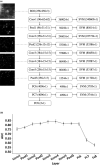Deep learning in medical imaging and radiation therapy
- PMID: 30367497
- PMCID: PMC9560030
- DOI: 10.1002/mp.13264
Deep learning in medical imaging and radiation therapy
Abstract
The goals of this review paper on deep learning (DL) in medical imaging and radiation therapy are to (a) summarize what has been achieved to date; (b) identify common and unique challenges, and strategies that researchers have taken to address these challenges; and (c) identify some of the promising avenues for the future both in terms of applications as well as technical innovations. We introduce the general principles of DL and convolutional neural networks, survey five major areas of application of DL in medical imaging and radiation therapy, identify common themes, discuss methods for dataset expansion, and conclude by summarizing lessons learned, remaining challenges, and future directions.
Keywords: computer-aided detection/characterization; deep learning, machine learning; reconstruction; segmentation; treatment.
© 2018 American Association of Physicists in Medicine.
Conflict of interest statement
MLG is a stockholder in R2/Hologic, scientific advisor, cofounder, and equity holder in Quantitative Insights, makers of QuantX, shareholder in Qview, and receives royalties from Hologic, GE Medical Systems, MEDIAN Technologies, Riverain Medical, Mitsubishi, and Toshiba. KD receives royalties from Hologic. RMS receives royalties from iCAD, Inc., Koninklijke Philips NV, ScanMed, LLC, PingAn, and receives research support from Ping An Insurance Company of China, Ltd., Carestream Health, Inc. and NVIDIA Corporation.
Figures







Similar articles
-
Overview of image-to-image translation by use of deep neural networks: denoising, super-resolution, modality conversion, and reconstruction in medical imaging.Radiol Phys Technol. 2019 Sep;12(3):235-248. doi: 10.1007/s12194-019-00520-y. Epub 2019 Jun 20. Radiol Phys Technol. 2019. PMID: 31222562 Review.
-
A gentle introduction to deep learning in medical image processing.Z Med Phys. 2019 May;29(2):86-101. doi: 10.1016/j.zemedi.2018.12.003. Epub 2019 Jan 25. Z Med Phys. 2019. PMID: 30686613 Review.
-
Pathology Image Analysis Using Segmentation Deep Learning Algorithms.Am J Pathol. 2019 Sep;189(9):1686-1698. doi: 10.1016/j.ajpath.2019.05.007. Epub 2019 Jun 11. Am J Pathol. 2019. PMID: 31199919 Free PMC article. Review.
-
Variability and reproducibility in deep learning for medical image segmentation.Sci Rep. 2020 Aug 13;10(1):13724. doi: 10.1038/s41598-020-69920-0. Sci Rep. 2020. PMID: 32792540 Free PMC article.
-
Deep computational pathology in breast cancer.Semin Cancer Biol. 2021 Jul;72:226-237. doi: 10.1016/j.semcancer.2020.08.006. Epub 2020 Aug 17. Semin Cancer Biol. 2021. PMID: 32818626 Review.
Cited by
-
Sounding out the hidden data: A concise review of deep learning in photoacoustic imaging.Exp Biol Med (Maywood). 2021 Jun;246(12):1355-1367. doi: 10.1177/15353702211000310. Epub 2021 Mar 27. Exp Biol Med (Maywood). 2021. PMID: 33779342 Free PMC article. Review.
-
Current Status and Future Perspectives of Artificial Intelligence in Magnetic Resonance Breast Imaging.Contrast Media Mol Imaging. 2020 Aug 28;2020:6805710. doi: 10.1155/2020/6805710. eCollection 2020. Contrast Media Mol Imaging. 2020. PMID: 32934610 Free PMC article. Review.
-
Predicting EGFR mutation, ALK rearrangement, and uncommon EGFR mutation in NSCLC patients by driverless artificial intelligence: a cohort study.Respir Res. 2022 May 27;23(1):132. doi: 10.1186/s12931-022-02053-2. Respir Res. 2022. PMID: 35624472 Free PMC article.
-
Automated detection and delineation of hepatocellular carcinoma on multiphasic contrast-enhanced MRI using deep learning.Abdom Radiol (NY). 2021 Jan;46(1):216-225. doi: 10.1007/s00261-020-02604-5. Epub 2020 Jun 4. Abdom Radiol (NY). 2021. PMID: 32500237 Free PMC article.
-
Technology-driven research for radiotherapy innovation.Mol Oncol. 2020 Jul;14(7):1500-1513. doi: 10.1002/1878-0261.12659. Epub 2020 Mar 19. Mol Oncol. 2020. PMID: 32124546 Free PMC article. Review.
References
-
- Amodei D, Ananthanarayanan S, Anubhai R, et al. Deep speech 2: end‐to‐end speech recognition in English and Mandarin. In: International Conference on Machine Learning; 2016:173–182.
-
- Peters ME, Neumann M, Iyyer M, et al. Deep contextualized word representations; 2018. arXiv preprint arXiv:1802.05365.
-
- Zoph B, Vasudevan V, Shlens J, Le QV. Learning transferable architectures for scalable image recognition, 2; 2017. arXiv preprint arXiv:1707.07012.
-
- Silver D, Huang A, Maddison CJ, et al. Mastering the game of go with deep neural networks and tree search. Nature. 2016;529:484–489. - PubMed
-
- Gandhi D, Pinto L, Gupta A. Learning to fly by crashing; 2017. arXiv:1704.05588.
Publication types
MeSH terms
Grants and funding
LinkOut - more resources
Full Text Sources
Other Literature Sources
Medical

